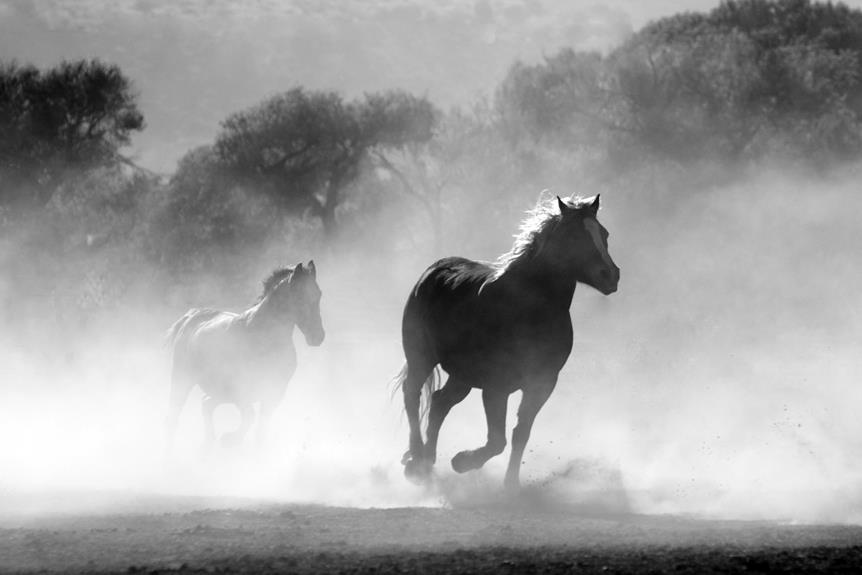Alrighty then, let's talk about how tall a horse really is.
You might be surprised to learn that these majestic creatures aren't measured in feet or meters like the rest of us. Oh no, they have their very own unit of measurement called hands.
Now, you're probably wondering how many hands make up a horse, right? Well, I won't keep you hanging for too long. Just know that the height of a horse is measured in hands, and I'll reveal all the juicy details soon enough.
So saddle up and let's embark on this equine exploration together.
Key Takeaways
- Horses have an average height range of 13.3–17.3 hands tall.
- Height variations exist among different horse breeds and types.
- Accurate height measurements are important for breed standards, competition divisions, and equipment sizing.
- Measuring a horse's height involves using a measuring stick or tape measure, and the measurement is taken from the ground to the highest point of the withers.
Average Horse Height
On average, horses stand at a height of 13.3–17.3 hands tall, with variations based on breed and type. The height of a horse is an important measurement that helps categorize them and determine their suitability for certain activities. To measure a horse's height, a measuring tape is used from the ground to the highest point of their withers, which is the ridge between their shoulder blades. The unit used to measure horse height is called a hand, which equals 4 inches. This historical unit makes it easier to communicate and compare horse heights.
Understanding the average height of horses is crucial for various purposes. It helps establish breed standards, as different horse breeds have specific average height ranges. For example, the American Warmblood stands at an average height of 15–17 hands, while the Arabian horse averages at 14.1–15.1 hands. Additionally, accurate height measurements are essential for competition divisions, ensuring fair competition among horses of similar sizes.
Knowing a horse's average height also aids in record-keeping and documentation. It allows for precise descriptions and identification, making it easier to track a horse's growth and monitor any changes in their size and weight over time. Overall, understanding the average height of horses is essential for various aspects of horse management and care.
Horse Height Chart
To easily compare and visualize the heights of different horse breeds, a horse height chart provides a clear and concise reference.
When it comes to measuring a horse's height, there are a few methods you can use. The most common method is to use a measuring stick specifically designed for horses. These sticks have measurements marked in hands, which is a unit of measurement equal to four inches.
To accurately measure your horse's height, place the measuring stick vertically against the highest point of the withers, which is the area between the horse's shoulder blades.
Another method is to use a tape measure. Starting from the ground, measure up to the highest point of the withers.
It's important to measure your horse's height accurately, as it helps in choosing the right size of equipment, such as saddles and blankets.
Additionally, knowing your horse's height is essential when comparing it to the average height of different horse breeds.
Why Horses Are Measured in Hands
Horses are measured in hands, a unit of measurement equal to 4 inches, from the ground to the highest point of the withers. But why are horses measured in hands? Here are four reasons:
- Historical Origins: The term 'hand' as a unit of measurement for horses originated in ancient Egypt. It was later standardized by King Henry VII of England to create a consistent unit of measurement for horse height. This historical significance has carried on to the present day.
- Practicality: Measuring a horse's height in hands is a practical way to determine the right size horse for various activities such as riding, racing, or showing. It allows for easy comparisons between different horses and helps ensure the right match between horse and rider.
- Widely Accepted: The use of hands as a unit of measurement is widely accepted in English-speaking countries and the British Empire. Measuring sticks marked with hand intervals are commonly used, making it easier to measure the height accurately with a measuring tape.
- Breed Standards: Different horse breeds have varying height ranges. Classifying horses by hands allows for adherence to breed standards and helps maintain consistency within each breed. It also ensures fair competition divisions, as horses of similar height are grouped together.
Understanding why horses are measured in hands is essential for accurate record-keeping, breed standards, and fair competition. So the next time you wonder how tall a horse is, remember that measuring in hands has a rich historical significance and practical purpose in the equestrian world.
How to Measure a Horse
When it comes to accurately measuring a horse, it's important to know how to properly measure its height from the ground to the highest point of the withers. To measure a horse, you'll need a measuring stick marked with hand intervals.
First, position the horse on level ground and make sure it stands square. Place the measuring stick against the horse's shoulder and extend it vertically until it reaches the highest point of the withers. Take note of the point where the horse's withers meet the measuring stick. This measurement will give you the horse's height in hands.
Horses are typically measured in hands, with 1 hand equaling 4 inches or 101.6 millimeters. If you need to convert the horse's height from inches or centimeters to hands, simply divide the height by 4, with the decimal indicating any extra length.
It's important to use a soft tape measure or a horse weight tape for accuracy. Measuring a horse accurately is crucial for competition purposes and for determining the appropriate dosage of medicines.
Horse Weight Management Tips
For effective horse weight management, regularly weigh or estimate your horse's weight to accurately monitor its health and make necessary adjustments to its feeding and medication. Knowing your horse's weight is essential for maintaining its overall well-being.
Here are some tips to help you manage your horse's weight effectively:
- Consult a vet or equine nutrition specialist: Seek professional advice to develop a weight management plan tailored to your horse's specific needs. They can provide valuable guidance on diet, feeding routines, and exercise.
- Adjust feeding and grazing routines: Modify your horse's feeding routine and grazing time based on its weight, activity level, and individual requirements. Be mindful of the quality and quantity of feed to ensure a balanced diet.
- Manage underweight horses: Provide quality roughage, such as hay or pasture, and consider increasing grazing time. Adjust the diet to meet their energy needs and work level, ensuring they receive adequate nutrients for healthy weight gain.
- Manage overweight horses: Review your horse's feed and monitor calorie intake. Consider reducing the amount of concentrated feed and increasing exercise gradually to promote weight loss. Implementing a weight loss plan gradually is important to avoid any adverse effects on their health.
To measure your horse's weight accurately, you can use an equine or livestock scale. However, if this isn't available, there are alternative methods such as estimating weight using a horse weight formula based on measurements of the horse's body length and girth. Remember to measure your horse's body correctly for accurate results.
Frequently Asked Questions
How Tall Is a Horse in Feet?
A horse's height is typically measured in hands, not feet. The average horse stands between 13.3-17.3 hands tall, with factors like breed and discipline affecting their size. You can estimate a horse's height without measuring by comparing it to known objects.
How Tall Is a Horse That Is 12 Hands?
A horse that is 12 hands tall is approximately 48 inches or 122 centimeters in height. This falls within the average horse height range.
How Tall Is a Horse From Ground to Head?
On average, horses can range from 14 to 17 hands tall, but different breeds have different average heights. Factors like genetics, nutrition, and overall health can affect a horse's height. The tallest horse ever recorded was 20.2 hands tall. A horse's height can impact its performance in various disciplines, as taller horses may have longer strides or more power. Compared to other animals, horses are generally taller. A horse's height is closely related to its weight, as taller horses tend to weigh more. The impact of height on a horse's health and longevity can vary, as certain health issues may be more common in larger or smaller horses. Estimating a horse's height based on its proportions can give a rough estimate, but measuring with a measuring stick or tape is the most accurate method. Some of the tallest horse breeds in the world include the Shire, Clydesdale, and Percheron.
How Tall Is 54 Inches in Horses?
54 inches is equivalent to 14 hands, which falls within the average height range of a light riding horse. It's taller than the average pony and suitable for various riding activities.
Conclusion
In conclusion, accurately measuring a horse's height is important for various reasons, including competition purposes and overall management.
The average horse measures between 13.3-17.3 hands tall, with one hand equaling 4 inches.
Different horse breeds have different average heights, with ponies being shorter than 14.2 hands and draft horses being 16-18 hands tall.
By understanding the importance of measuring a horse's height and utilizing the appropriate techniques, owners can ensure the well-being and success of their horses.



0 Comments